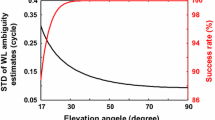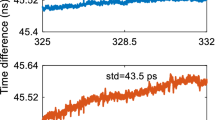Abstract
This paper presents a general modeling strategy for ambiguity resolution (AR) and position estimation (PE) using three or more phase-based ranging signals from a global navigation satellite system (GNSS). The proposed strategy will identify three best “virtual” signals to allow for more reliable AR under certain observational conditions characterized by ionospheric and tropospheric delay variability, level of phase noise and orbit accuracy. The selected virtual signals suffer from minimal or relatively low ionospheric effects, and thus are known as ionosphere-reduced virtual signals. As a result, the ionospheric parameters in the geometry-based observational models can be eliminated for long baselines, typically those of length tens to hundreds of kilometres. The proposed modeling comprises three major steps. Step 1 is the geometry-free determination of the extra-widelane (EWL) formed between the two closest L-band carrier measurements, directly from the two corresponding code measurements. Step 2 forms the second EWL signal and resolves the integer ambiguity with a geometry-based estimator alone or together with the first EWL. This is followed by a procedure to correct for the first-order ionospheric delay using the two ambiguity-fixed widelane (WL) signals derived from the integer-fixed EWL signals. Step 3 finds an independent narrow-lane (NL) signal, which is used together with a refined WL to resolve NL ambiguity with geometry-based integer estimation and search algorithms. As a result, the above two AR processes performed with WL/NL and EWL/WL signals respectively, either in sequence or in parallel, can support real time kinematic (RTK) positioning over baselines of tens to hundreds of kilometres, thus enabling centimetre-to-decimentre positioning at the local, regional and even global scales in the future.
Similar content being viewed by others
References
Datta-Barua D, Walter T, Blanch J, Enge P (2006) Bounding higher order ionosphere errors for the dual frequency GPS user. In: Proceedings of ION GNSS 2006, 26–29 September, Fort Worth, TX, pp 1377–1392
De Jonge PJ, Teunissen PJG, Jonkman NF, Joosten P (2000) The distributional dependence of the range on triple frequency GPS ambiguity resolution. In: Proceedings of ION-NTM 2000, 26–28 January, Anaheim, CA, pp 605–612
Feng Y, Rizos C (2005) Three carrier approaches for future global. regional and local GNSS positioning services: concepts and performance Perspectives. In: Proceedings of ION GNSS 2005, 13–16 September, Long Beach, CA, pp 2277–2787
Feng Y, Moody M (2006) Improved phase ambiguity resolution using three GNSS signals, PCT/AU2006/000492. http://www.wipo.int/pctd. Accessed April 2006
Forssell B, Martin-Neira M, Harris RA (1997) Carrier Phase Ambiguity Resolution in GNSS-2. In: Proceedings of ION GPS-97, 16–19 September, Kansas City, MO, pp 1727–1736
Han S (1997) Ambiguity recovery for long-range kinematic positioning. Navigation 44(2): 257–290
Han S, Rizos C (1999) The impact of two additional civilian GPS frequencies on ambiguity resolutions strategies. Proceedings of ION Annual Technical Meeting, 28–30 June, Cambridge, MA, pp 315–321
Hatch R (2006) A new three-frequency, geometry-free technique for ambiguity resolution. In: Proceedings of ION GNSS 2006, 26–29 Sept, Fort Worth, TX, pp 309–316
Hatch R, Jung J, Enge P, Pervan B (2000) Civilian GPS: the benefits of three frequencies. GPS Solu 3(4): 1–9
Klobuchar JA (1996) In: Parkinson B, Spilker J, Axelrad P, Enge P (eds) Ionospheric Effects on GPS, global positioning system: theory and application, vol I. American Institute of Aeronautics and Astronautics, pp 485–515
Mirsa P, Enge P (2004) Global positioning systems, signals, measurements and performance. Ganga-Jamuna Press, Lincoln, pp 227–254
Teunissen PJG (1995) The least-squares ambiguity decorrelation adjustment: a method for fast GPS integer ambiguity estimation. J Geod 70(1–2): 65–82
Teunissen PJG, Jonkman NF (2001) Will geometry-free full ambiguity resolution be possible at all for long baselines. In: Proceedings of ION-NTM 2001, 22–24 January, Long Beach, CA, pp 271–280
Teunissen PJG, Joosten P, Tiberius CCJM (1999) Geometry-free ambiguity success rates in case of partial fixing. Proceedings of ION-NTM 1999, 25–27 January, San Diego, CA, pp 201–207
Teunissen PJG, Joosten P, Tiberius CCJM (2002) A comparison of TCAR, CIR and LAMBDA GNSS ambiguity resolution. In: Proceedings of ION GPS, 24–27 September, Portland, Oregon, pp 2799–2808
Verhagen S (2006a) How will the new frequencies in GPS and Galileo affect carrier phase ambiguity resolution? Inside GNSS, 2
Verhagen S (2006b) Improved performance of multi-carrier ambiguity resolution based on the LAMBDA method. In: Proceedings of Navitec 2006, ESA-ESTEC, Noordwijk, NL, p 8
Vollath U (2004) The factorized multi-carrier ambiguity resolution (FAMCAR) approach for efficient carrier-phase ambiguity estimation. In: Proceedings of ION GNSS 2004, 21–24 September, Long Beach, CA, pp 2499–2508
Vollath U, Birnbach S, Landau H (1998) Analysis of three carrier ambiguity resolution (TCAR) technique for precise relative positioning in GNSS-2. In: Proceedings of ION GPS 1998, pp 417–426
Wang J (1999) Stochastic modelling for RTK GPS/GLONASS positioning. Navigation 46(4): 297–305
Werner WJ, Winkel J (2003) TCAR and MCAR Options With Galileo and GPS. In: Proceedings of ION GPS/GNSS 2003, 9–12 September, Portland, OR, pp 790–800
Xu P (2001) Random Simulation and GPS decorrelation. J Geod 75(7–8): 408–423
Zheng Y, Feng Y (2005) Interpolating esidual zenith tropospheric delays for improved regional area differential GPS positioning. Navigation 52(3): 179–187
Author information
Authors and Affiliations
Corresponding author
Rights and permissions
About this article
Cite this article
Feng, Y. GNSS three carrier ambiguity resolution using ionosphere-reduced virtual signals. J Geod 82, 847–862 (2008). https://doi.org/10.1007/s00190-008-0209-x
Received:
Accepted:
Published:
Issue Date:
DOI: https://doi.org/10.1007/s00190-008-0209-x




